Art World
How a $41 Million Luxury Hotel Is Sustaining an Ambitious Arts and Ecology Initiative on a Remote Canadian Island
The project's founders hope to wed a capitalist drive with a socially conscious sensibility.
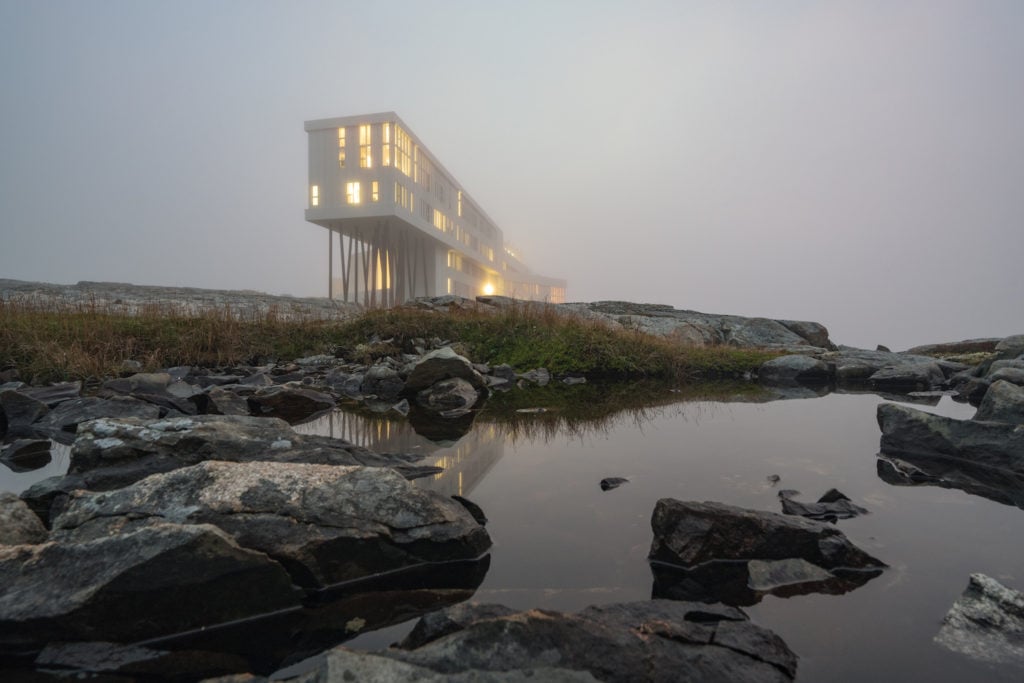
The project's founders hope to wed a capitalist drive with a socially conscious sensibility.

Kate Brown

As Jeff Koons’s Rabbit went under the hammer for $91 million at Christie’s a few weeks ago, I stood on a ferry deck off the coast of Northeastern Canada with no internet, hands clutching a rail as the boat cut through packs of ice. It’s increasingly rare to be isolated like this. In cyberspace, pre-Basel noise was filling up my inbox. But here I was, happy with the deafening quiet as the ferry crawled across frigid water to Fogo Island.
This small and sparsely populated ex-fishing island off the coast of Newfoundland, a Canadian province on the Atlantic, is not a place you can get to without concerted effort. From any major North American city, it takes at least one plane, a car, and a ferry to get here. Caribou, partridgeberry shrubs, and lichen preside over the small communities that dot the island. And the only passers-by are icebergs, heading south from the arctic.
Yet the region has been gaining in art-world prominence thanks to Fogo Island Arts, an initiative founded in 2008 by Zita Cobb, an eight-generation Fogo Islander who left the region when she was 17 and, in the late 1990s, returned as a multimillionaire former chief financial officer. In just over ten years, Cobb and her team, including strategic director Nicolaus Schafhausen, the former director of the Kunsthalle in Vienna, have established residency, exhibitions, and talks programs, a publishing arm, and educations initiatives aimed at local and international audiences. There are also vernacular architecture projects, heritage boat-building initiatives, and residencies for geologists. With their multipronged initiative, they hope to tap into the island’s ecological roots.
However the most striking part of their plan is a mammoth luxury hotel that hangs on the shoreline: the Fogo Island Inn, where rooms cost upwards of $1,500 a night. Run as a social enterprise, the inn’s profits are reinvested into the Shorefast Foundation, the umbrella charity of Fogo Island Arts.
“People who control economic power have a limited understanding of what has value,” says Cobb, sitting with me in one of the inn’s quiet alcoves. “What if they actually asked what has inherent value? How can we use our money to support and develop that? That is what we have been doing, and people can learn from that.”
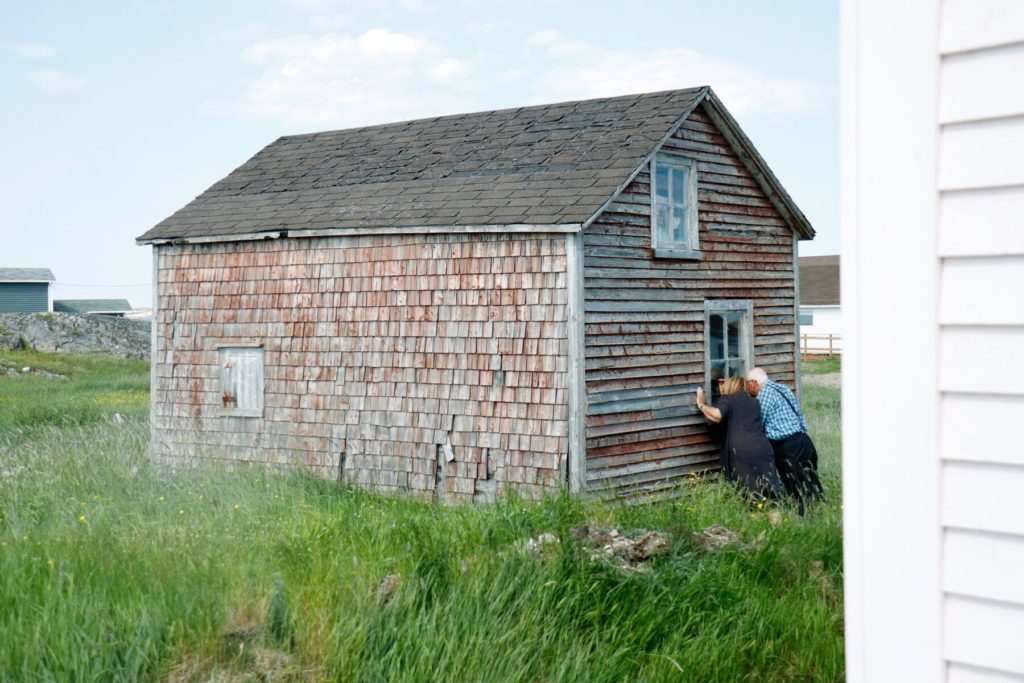
A traditional structure on Fogo Island. Courtesy Fogo Island Arts.
Cobb, like many Fogo Islanders of her generation, grew up without electricity or running water, and her family relied entirely on fishing to survive. Despite her later successes (she walked away with $69 million when the fiber optics company where she was CFO was sold in 1999), the entrepreneur is disarmingly down-to-earth. When one of the current artists-in-residence first arrived in May, she handed him a book called Cod: A Biography of the Fish That Changed the World.
Cod fishing was once the island’s main economic engine. But the industry went through intense changes in the late 1960s with the advent of industrial fishing. The boom saw the industry leap from the 19th century straight into the 21st, Cobb says, and overfishing rapidly depleted the cod supply. Jobs dried up in a few short decades, following hundreds of years of stability for European settlers. Cobb’s family managed to stay, but the island saw its population of 6,000 shrink by about half as people took off and looked for opportunities elsewhere.
When Cobb returned to the island, she decided to reinvest her wealth to bring self-renewing economic sustainability. In 2008, she established the Shorefast Foundation, which provides micro-loans for small businesses, supports ocean sustainability initiatives, and works to restore Fogo Island’s unique architectural landmarks.
Shorefast has now become a dominant landowner on the island, buying up old salt box houses, churches, a school, and the town hall. One of its several properties is a two-room house from the mid-1880s that has since been delicately renovated into a sort of museum of its own history, telling the story of how islanders used to live and work.
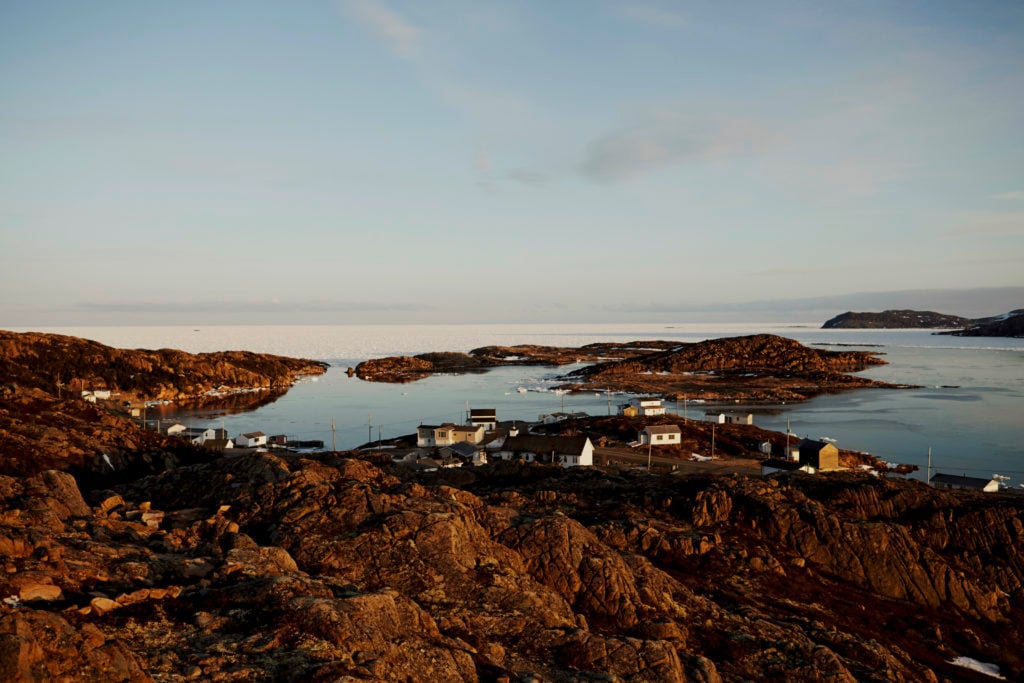
Fogo Island, which hosts Fogo Island Arts, is a remote region in Canada’s northeast province of Newfoundland. Courtesy Fogo Island Arts.
Then there is the hotel, a resplendent, $41 million building with 29 rooms that have been featured in international lifestyle, travel, and architecture magazines. Moneyed guests who don’t want to endure the extensive travel process can arrive by helicopter—a luxury few Fogo Islanders could afford.
Predictably, there has been some displeasure on the island. “Some people complained—we felt like Shorefast took all our good ideas,” one resident told me with a smile. “But, then again, we didn’t do it, did we?”
Shorefast, for its part, has tried to involve the community. Skilled local workers are sought out first for any employment opportunities, and the hotel’s bespoke furniture, knitted wares, and striking quilts all come from the island. Although Cobb and Schafhausen acknowledge that, when it comes to the specter of gentrification, they are “playing with fire,” they stress that profits are reinvested into community projects. Moreover, they say, they are growing the economy: last year, Shorefast had 240 employees, up from 193 in 2016. The projects are not even necessarily about generating return, Cobb says. “How can you give back something that is already owned by the community?”
Schafhausen adds that the Shorefast Foundation is encouraging a necessary population influx. He likens the economic situation on the island to that of Germany, where by 2030, there will be a lack of 3 million skilled workers. “This island also needs people,” he says while showing me renderings of small, furnished houses that one day could host new residents.
“This initiative is about making relationships,” Cobbs says, noting that supporters of Shorefast don little cauliflower pins to remind them that they are all florets on a larger stem. “For people that come here and have had a physical relationship to a place before, they find that re-awakened. For those who maybe never had that kind of relationship to a place, it becomes a major experience.”
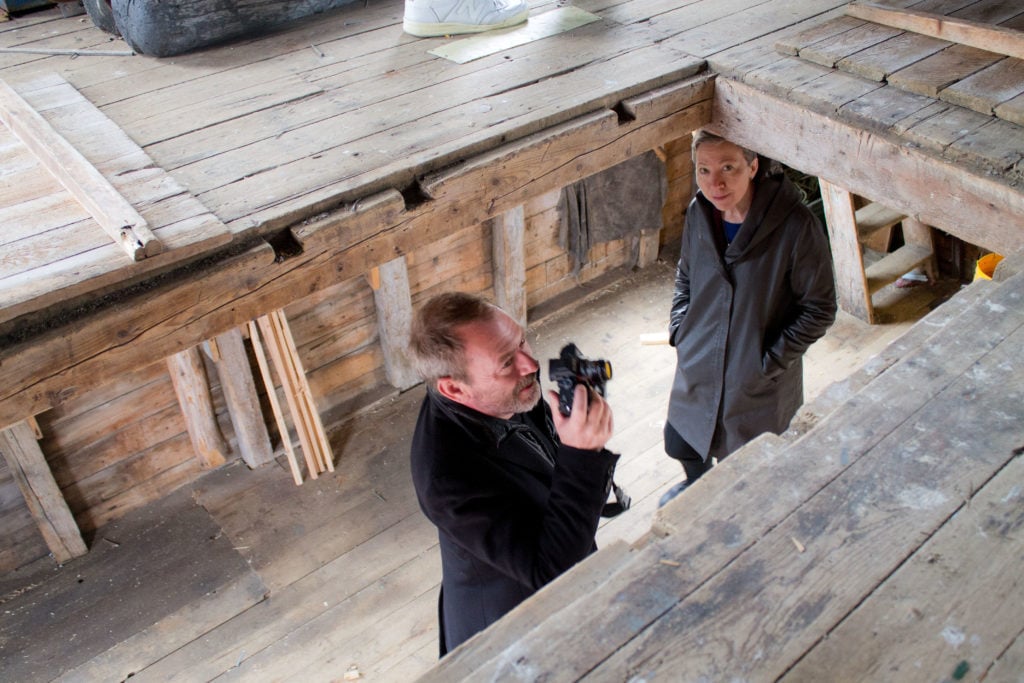
Fogo Island Arts and Shorefast founder Zita Cobb (right) with artist Liam Gillick. Courtesy Fogo Island Arts.
But in the end, Cobb is quick to remind everyone that Shorefast all started with art—and artists, indeed, are a key focus of her foundation.
Willem de Rooij, Jeremy Shaw, and Augustas Serapinas are among those who have had temporary studios here. Schafhausen, who leads the program’s selection process, explains that people are chosen not for what they make, but rather for the way they think.
During the program’s inaugural arts weekend this May, among the international art guests to the Canadian island was British artist and writer Liam Gillick. “Who is in command of their own destiny and their material? That’s why I am here, partly,” Gillick told a crowd of patrons and locals, including members of the greater Newfoundland art scene who traveled here. “It’s interesting to see art here dealing with production, not consumption.”
Gillick was sitting with Defne Ayas, co-curator of the 2020 Gwangju Biennale, against a backdrop of rocks and ocean in the Long Studio, one of four striking spaces built by Newfoundland-born, Norway-based architect Todd Saunders. Over the course of four days, local artists—woodworkers, metalworkers, painters, sculptors, and jam-makers included—opened their doors to whoever came into town. But a more central aim is for the islanders to visit each other. Erin Hunt, a Fogo Island resident and painter whose studio is in a old courthouse, tells me that it’s rare for her to receive local visitors.
Schafhausen says the entire project is about opening dialogues. “In general, how can people benefit from each other?” he asks me. “More and more, people are in their specialized worlds. Artists, considered a part of the contemporary art scene, are centralized in urban places.”
He says similar a psychological remoteness exists in big hubs, in neighborhoods, and in the virtual world. Isolated communities are often stacked on top of one another, though they may have little awareness or understanding of each other. “Being a director of institutions for 25 years in large cities, I always struggled with the same problems we struggle with here.”
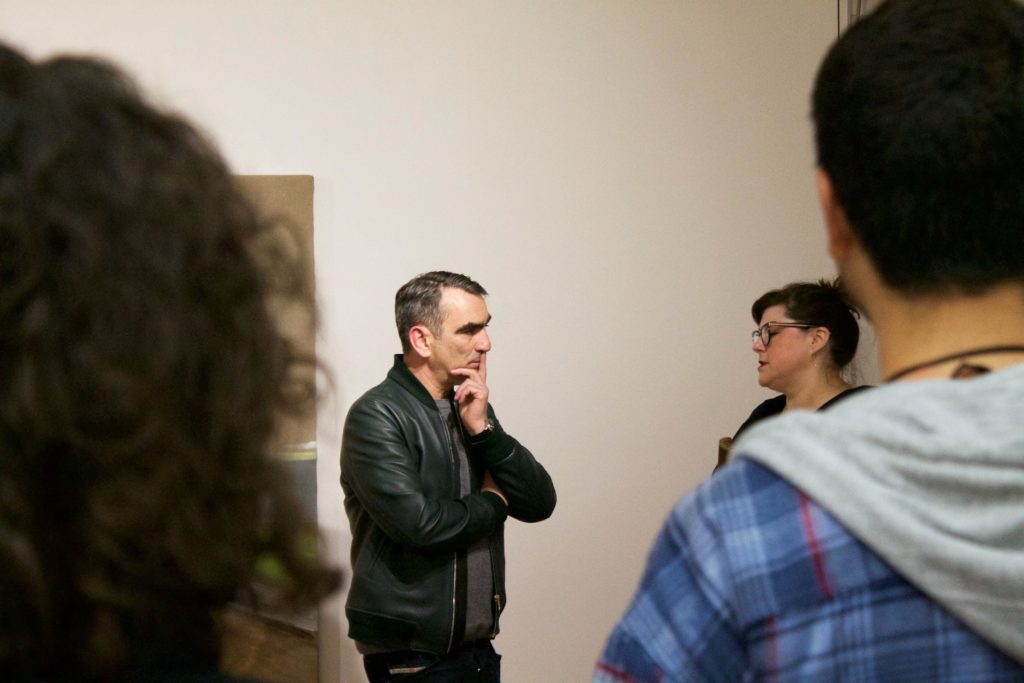
Strategic director Nicolaus Schafhausen and artist Brenda Draney. Courtesy Fogo Island Arts.
Gillick touched on some of those similarities in his talk with Ayas. “It might be the case that the quilt workshop has more in common with Jeff Koons than an Uber driver does, because they both control the means of production,” Gillick told a small crowd.
But even though Cobb is invested in sharing resources and knowledge, she says that different languages need to coexist in a healthy, heterogenous community.
“If you took the people from the Long Studio and put them out at the crab plant, they would think they had gone to the moon,” she says. “And do you think the crab fishermen are worried about whether they are being inclusive enough to the art people? I think we are over-stressing the [problem]. If we try to make a world where everybody can participate in everything at some level, we will have flattened knowledge so much, we will have none left.”
In that sense, Fogo Island Arts and the wider Shorefast initiative offer productively contradictory ideas about the value of place, who belongs where, and how communities live, die, and regenerate—all problems that have no absolute answers.
Towards the end of his visit, Gillick remarked that, before he ever came to the island, he looked at maps to learn what he could about Fogo. “Now I am here, and I feel like I don’t know anything,” he said, noting his observations of colorful lichen and rock surfaces. “This island has surprised me.”
I think I know what he means. As soon as you step off the ferry, what becomes instantly clear is that the international contemporary art and business worlds—and all of human life—are on the periphery of Fogo Island’s fantastic, intimidating nature. To make it here, people have to rely on each other, always. It’s humbling.